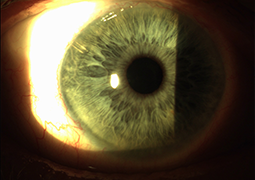Aim: To evaluate the safety and efficacy outcomes of PRESERFLO™ MicroShunt implantation in patients with primary open-angle glaucoma.
Material and Methods: Retrospective data analysis of 19 eyes of 12 patients, comprising 5 females and 7 males. The patients underwent surgery between August 2020 and February 2022. The follow-up period was 24 months after surgery. During the follow-up period, intraocular pressure (IOP), the need to apply topical antiglaucoma medication and its spectrum, visual field status, optic nerve target findings and postoperative complications were recorded. The indication for PRESERFLO™ MicroShunt implantation was primary open angle glaucoma (POAG), poorly controlled with maximum tolerated medical therapy.
Results: Average IOP was reduced from 19.05 ±5.58 mmHg preoperatively to 11.47 ±2.48 mmHg at 3 months postoperatively, 12.26 ±2.48 mmHg at 6 months postoperatively, 14.0 ±2.43 mmHg at 12 months postoperatively, 11.78 ±2.37 mmHg at 18 months postoperatively, and 12.73 ±2.51 mmHg at 24 months postoperatively (p < 0.001).
No antiglaucoma medication was required in 19 eyes 3 months after surgery, in 19 eyes 6 months after surgery, 19 eyes 12 months after surgery, 16 eyes 18 months after surgery and 15 eyes 24 months after surgery. One eye (5.26%) required monotherapy 18 months after surgery, and 2 eyes (10.52%) 24 months after surgery. Dual combination therapy was required 18 months after surgery in 2 eyes (10.52%) and 24 months after surgery in 2 eyes (10.52%). In the early postoperative period we found a loose conjunctival suture in 3 eyes, which was followed by resuturing in 1 eye. In the late postoperative period we found an obturated implant in 1 eye, which required implant replacement.
Conclusion: Our initial results suggest that the PRESERFLO™ MicroShunt glaucoma implant is an effective surgical technique with minimal postoperative complications, resulting in a statistically significant reduction in average IOP and discontinuation or reduction of topical antiglaucoma medication for 2 years after surgery.

